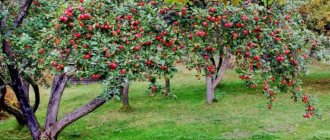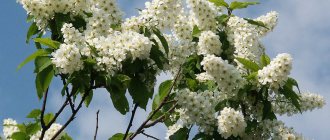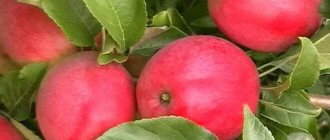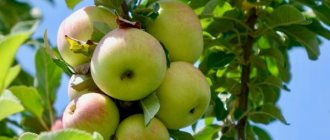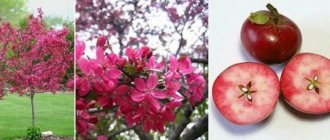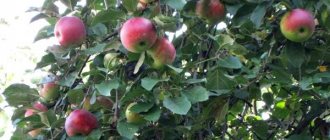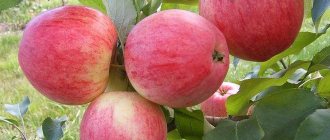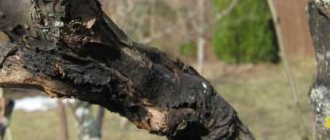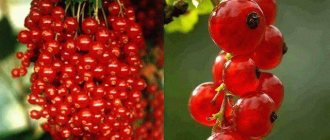Old variety does not mean bad. Among them there are new cultivars that are not inferior in yield and quality of fruit, as evidenced by the characteristics and description of the Melba apple tree variety. Brought out at the end of the 19th century, it is still popular and in demand. Perhaps the tree’s resistance to frost or pests leaves much to be desired, but consumers like the excellent taste and are of little interest in the subtleties of care. But for gardeners, on the contrary, it is useful to have all the information when buying seedlings.
Apple tree Melba
Melba apple tree (description, photo you will find below) is a variety of apple trees known throughout the world. Brought out by breeders from Canada at the end of the 19th century, it was named after the name of a famous opera singer who was successfully touring in those years.
After the first harvests, apple trees of the Melba variety were brought to European countries and Russia. In the 20th century, this variety was included in the state register under the name "Melba" , but many gardeners still call apple trees of this variety in the old fashioned way - "Melba".
A variety of summer-ripening fruits that does not have high winter hardiness. For this reason, the apple tree has not become widespread in the North of our country and the Far East; in other regions this variety has been zoned and is successfully grown.
The most famous zoned species is Red Melba (Red Melba) , which is more resistant to frost (see photo and description of the variety in the “Variety Varieties” section).
Important! The apple tree of this variety begins to bear fruit in the 3rd-4th year of development; the apples ripen at the end of summer, have good taste, are transportable and can be stored fresh for a long time.
A brief excursion into history
Back in the nineteenth century, when no one had ever heard of such a science as genetics, breeding scientists obtained varieties based on their intuition, and often simply sowed seeds and selected the most successful seedlings in order to propagate them. This is exactly how the Melba variety was obtained in Canada (Ottawa). It was the best in comparison with other seedlings that were bred by sowing seeds of the Mackintosh variety; pollination of its flowers was free. Perhaps the author of the culture had a strong worship of opera - the variety was named after the Australian singer Nellie Melba. This event took place in 1898. Time passed, the “Melba” variety was taken as a basis and new varieties were created, but their “mother” can be found in almost any garden plot.
Characteristic
Further in the article, a description and reviews are given about the “Summer Melba” variety so that you can decide on choosing it for your site.
Also in this video you can see what an adult Melba tree looks like:
Height
Melba is a medium-sized variety , the height of the tree does not exceed 4 meters , the most typical height is 3.0 meters.
Crown width
At the age of up to 3 years - columnar in shape , then a crown is formed.
The crown is medium spreading, round in shape, slightly elongated upward. The diameter can reach 7 meters. The trunk is thick, the bark is dark brown. The leaves are oblong in shape, crenate along the edges, and light green in color. The branches are of medium thickness, slightly drooping.
Crown of an adult Melba.
Tasting assessment
The fruits are large , round, slightly elongated downward and slightly flattened, yellow-green in color with red stripes . The skin is dense, but not rough, but tender and smooth.
The weight of the fruit is 120 - 150 grams , but can be larger. The pulp is juicy, white with a sweet and sour taste and candy aroma. On a five-point scale, ratings are rated at an average of 4.5.
Ripe Melba fruits.
Self-fertility
The Melba variety is a self-fertile variety , but it copes with this task ineffectively, so it is recommended to plant it next to pollinating apple trees.
Winter hardiness
The winter hardiness of this variety is average, but varieties of the variety such as Melba Red and Melba's daughter are more winter hardy.
Pollinator varieties
The following varieties are used most effectively and successfully for additional pollination of this variety of apple trees:
- Antonovka;
- Suislepskoe;
- Borovinka;
- Stark Earlist;
- Bellefleur is Chinese.
Boletus is one of the best pollinators for Melba.
Beginning of fruiting
Melba apple trees bear fruit 4 years after planting. At first they bear fruit regularly , then after 12 years of development, some cyclicity , when the year of fruiting alternates with a year of rest.
The productivity of this variety is high.
Seedling cost
Depending on the region of residence, the cost of seedlings may differ slightly, but to understand the order of prices, you can consider several regions, these are:
- Moscow and St. Petersburg , at the age of: 3 years – 1000.00 rubles;
- 4 years – 2500.00 rubles;
- 5 years – 6000.00 rubles.
- 3 years – 320.00 rubles;
- 3 years – 220.00 rubles;
- 3 years – 300.00 rubles;
In this video you can see an overview of the Melba apple tree:
Reviews from gardeners
Since this variety has been known for a long time and has become widespread in different regions of our country, there are a lot of opinions about it.
Oleg (Rostov-on-Don): “...in my youth, my grandmother had Melba apple trees. I loved these apples. They are small, juicy, sweet. Apples are good for processing and storage. They made juice from these apples.”
Nikolay (Krasnodar region): “I discovered Melba - a magnificent variety. When it begins to bloom, the aroma floats through the garden, which even words cannot describe. I have 4 apple trees of this variety.”
Olga (Nizhny Novgorod region): “Melba is a wonderful holiday, and it doesn’t matter whether it blooms or the fruits ripen! My Melba is already 25 years old, it’s sad, but the tree is getting old and we will soon say goodbye to her. I will definitely buy it and plant it again.”
Ripening period
Melba apple trees bloom in early spring . Large flowers range in color from white to pink with purple veins.
The fruits ripen regularly, starting from the 4th year and abundantly from the 8th year. Later, in the second ten, an alternation of years of rest begins.
The apples ripen at the end of summer (second half of August) and are quite large, usually 120 - 130 grams, but sometimes up to 200 grams. The peduncle is thin and short in length.
Important! Apples do not ripen all at once, but spread out over time, which allows 1.5 months to harvest fresh fruits.
The apples drop as they ripen , but if harvested by hand, the fruits can be stored for several weeks or even months.
Apples are delicious, sweet and sour, have a candy aftertaste, with a lot of vitamins and acids. Apples contain a lot of active beneficial elements.
Harvest and storage
When apples ripen, they fall off and quickly deteriorate, so they are not suitable for storage. They need to be picked straight from the tree while still a little green. The fruits are placed in wooden boxes in several layers. Paper or hardwood sawdust is laid between them. The apples should not touch each other.
The fruits should be collected in dry, sunny weather. Store them in a dark and dry place at a temperature from -1 to +7 degrees. If the humidity in the room is high, the crop will quickly deteriorate. The variety also tolerates transportation well over long distances.
Advantages and disadvantages
The positive characteristics of this variety include the following:
- Early fruiting;
- Fast tree growth;
- High yields;
- A beautiful view, a blooming image, pleasing to the eye and a wonderful aroma;
- High indicators of fruit strength and durability, and, accordingly, their transportability;
- A large set of useful elements;
- Wide range of recycling uses.
Melba apple tree blossoming.
The disadvantages of this variety include:
- Average frost resistance;
- Susceptibility to scab;
- Low self-fertility;
- Unregulated cyclicity of fruiting in adult apple trees over 10 years of age.
Variety varieties
This apple tree has hybrid varieties with similar names:
- “Melba’s Daughter” is a frost-resistant hybrid and is almost not affected by scab. The fruits have pink spots or stripes. The weight of an apple is up to 130 g; an adult tree produces up to 35 kg of apples.
- “ Melba Red” (Melba red) - the hybrid is famous for the greenish-white surface of the fruit with a red blush and dots under the skin. Apples are less sweet. The weight of one apple is up to 150-200 grams, the yield of an adult apple tree is up to 80 kg.
Fruits of the apple tree Melba's daughter.
Apple tree fruits Melba Red.
The columnar apple tree Melba is not registered anywhere. Perhaps the confusion stems from the fact that Melba's crown really resembles a column until it is three years old.
Care
Young apple trees should be planted in late September - early October . The soil should preferably be loamy; if it has a different composition, it is necessary to prepare a place for planting a tree.
To do this, take sand, peat, manure or compost in equal parts, mix and place a young tree in a hole prepared in advance, cover everything with prepared soil and water it abundantly.
The pit must be at least 1.0 meters in diameter and 0.8 meters deep. The apple tree is also prepared for planting; for this, the crown is stripped of its leaves, and if the seedling is small and thin, then before planting it should be kept in water for several days to fill the stem with moisture.
Also in this case, when planting, it is necessary to install a stick (stake) in order to support the planted tree.
Advice! When planting, the root collar of the seedling should remain above the surface of the earth and be at its level. The earth in the tree trunk circle is crushed, but not compacted.
If there is close groundwater, it is necessary to provide drainage, because Excessive amounts of moisture can damage the root system and lead to the death of the seedling.
Pruning is carried out in early spring before the start of sap flow. This operation is carried out to rejuvenate the apple tree, sanitize it and remove root shoots.
The main trunk is shortened by 1/3 of the length, after which the side shoots begin to grow rapidly and branches are formed. During sanitary cleaning, dried and broken branches are removed.
fertilize Melba:
- In the spring, before flowering: for this, the tree trunk circles are dug up with humus and the addition of ash, superphosphate and potassium chloride;
- In summer: trees are fed with nitrogen-containing fertilizers, both natural in composition (manure, chicken droppings) and industrially produced (urea);
- In autumn, after harvesting : potassium chloride and compost.
Melba does not like waterlogging, so it should be watered carefully and only in dry weather at the rate of 10 liters per apple tree per week.
The main pests that cause damage to the apple tree:
- Scale insects, bark beetles, mites - damaging the bark;
- Caterpillars and beetles - damage foliage;
- Aphids - suck out juice;
- Codling moths attack fruits.
Preventive measures are used to control pests. To do this, before flowering, trees are treated with special preparations, of which there are a large number on the market.
Also a preventive measure is whitewashing the trunks of apple trees. To protect against rodents in winter, apple tree trunks are covered with insulating materials.
Whitewashing is a preventive measure against pests.
The diseases to which Melba is susceptible include scab, because the apple tree is quite resistant to others.
Attention! To prevent scab, you should carry out regular sanitary pruning, fertilize and remove fallen leaves.
In addition to preventive measures, chemical treatment is carried out, consisting of 3 stages:
- At the moment the buds open, the tree trunk is treated with ammonium nitrate and a solution of Bordeaux mixture is applied to the tree;
- At the moment of active color, the composition of the solutions and the treatment areas are the same;
- At the moment of apple formation, after 14 days the same procedure is carried out again.
If scab is detected on an apple tree, the following measures should be taken:
- 10 tablets of the Gamair bactericide are dissolved in 10 liters of water and sprayed 3 times per season;
- 20 ml of the drug Fitolavin is dissolved in 10 liters of water and 4 treatments are carried out per season.
In addition to those listed, there are a number of drugs that can be used to effectively combat the disease:
- Ammonium nitrate solution;
- Ammonium sulfate;
- Potassium salt;
- Potassium nitrate.
Diseases and pests
Regardless of whether the crown has a columnar or spherical shape, Melba is susceptible to diseases and insect pests. Overcoming pathologies is not easy, so the apple tree must be periodically treated for therapeutic and preventive purposes.
Apple scab
This disease is also caused by a fungus and appears 2 weeks after the start of flowering. The pathology has the following symptoms: velvety round spots on the leaves, brown corky traces in the form of a net on the fruits and their cracking, deformation of the affected buds.
To get rid of the problem, you need to destroy fallen leaves, which become a source of infection. In autumn or spring, spray the soil with urea (6%). The fungicide is used every 5 days during Melba flowering.
Powdery mildew
The disease is caused by a fungus and first appears before Melba blooms. The pathogen overwinters in the buds of infected shoots in the form of mycelium. The disease looks like a powdery white layer that covers all parts of the tree. Leaves begin to fall off prematurely, shoots stop growing, and buds dry out even before development begins. To overcome powdery mildew, it is necessary to remove the affected shoots and regularly water the plant.
The following measures are also needed:
- For prevention, you should spray your kidneys with a solution of copper or iron sulfate (2%).
- A drug containing sulfur will help destroy the disease.
- Fungicide treatment: Topas 100 EC. Processing is carried out in the bud phase.
To get rid of diseases as much as possible, you need to dig up the soil in the circle around the trunk every year. All measures must be applied in combination.
Apple tree pests and their control
The apple tree is also susceptible to damage by insects. The consequences of their life activity can be seen in the photo.
There are such pests and ways to combat them:
- Leaf roller. The butterfly is small in size, lays eggs on young leaves, and the hatched larvae completely eat them. They infect other trees quickly, so the entire garden will have to be treated. Rolled leaves need to be burned, birds that eat pest butterflies should be attracted, and insect traps should be made.
- Apple codling moth. The pest lays eggs in flower buds. The larva quickly gnaws out the seeds in the apples and moves on. Here you need to clean the bark twice a year and plant tomatoes around Melba, the smell of which insects do not like.
- Shield. She feeds on tree sap. It can be detected by dark small growths on the bark. Eggs laid by scale insects are not easy to destroy, because they can survive even in frost of 30 degrees. To eliminate the problem, copper sulfate Nitrafen is used. You can wash the barrel with a mixture of ash and tar soap.
- Flower beetle It lays larvae in the buds, so the apple does not even have time to set. A chlorophos solution will help destroy them. The bark should be cleaned using sticky films or whitewashing the apple tree with slaked lime.
Another pest is the gall aphid, which lurks inside unblown young leaves. Damage can reach 50% of the entire plant. Catching belts that prevent the carriers of aphids, ants, from rising will help get rid of the problem. In addition, insecticides must be used.
Nuances of cultivation and questions from readers
In the process of growing apple trees, gardeners in different regions of the country have questions:
When to plant: spring or autumn?
The most favorable time is autumn, but many gardeners plant in the spring, fearing the death of the apple tree during autumn planting, caused by the fact that the apple tree does not have time to take root before the onset of frost.
When planting an apple tree in the spring, it is recommended to prepare the holes in the fall; when planting in the fall, a month before the event.
In autumn, planting is carried out after the end of leaf fall , in spring - depending on weather conditions.
How to form a crown?
The crown is formed by performing sanitary planned pruning, carried out in spring and autumn in accordance with the given anti-aging pruning scheme, as well as for crown formation:
- In a young tree, the central shoot is shortened by one third, the lateral branches are cut off at the level of 2–3 buds;
- Then, for 2-3 years, they continue to cut the main shoot by a third of its length, and shoots growing at an angle of 45° are left on the branches that form the skeleton of the tree;
- The rest are cut to the first bud.
Crown formation diagram.
How to prune in the fall?
In the fall, remove damaged branches that can break off from the weight of the fruit, as well as dry and diseased branches.
What are the features of growing Melba?
Loamy, fertilized soils and groundwater drainage. The landing site should be protected from the wind, sunny and open.
What is the distance between apple trees?
The distance between apple trees should be 5-6 meters and 6-8 meters between rows.
However, in each specific case it is necessary to take into account:
- Features of the site;
- Region of residence;
- Nature of use (industrial, individual).
How to grow in the regions?
- In the middle zone , the variety is perfectly zoned and does not require any additional knowledge for successful cultivation.
- In Siberia , it requires the arrangement of appropriate shelter for the winter and planting on the leeward side, otherwise the growing conditions do not differ from usual ones.
- Melba apple trees are planted in autumn in the Urals in late autumn. Choose fertile soil with deep groundwater. In winter, the circle around the trunk is covered with peat and humus, and on top with leaves and snow.
- For the Moscow region and Leningrad region - it requires additional care due to possible scab infection, especially during a prolonged period of rain. To protect against frost, care should also be taken to protect the tree.
- For the southern Urals , cultivation in this region does not differ from those recommended by breeders. According to gardeners in this region, Melba is a “sweet” variety of the Southern Urals.
General recommendations are as follows: there are no particular differences in cultivation.
The only rule is that in places where prolonged frosts are possible, it is necessary to cover the tree and take preventive measures against diseases such as scab.
Which variety is better: Candy, Mantet or Melba?
Which variety is better, each gardener chooses for himself individually , depending on his region of residence and personal preferences. Below is a table for comparing these varieties when grown in the Samara region:
| Name | Taste, points | Sugar to acid ratio, % | Beginning of mature carrion | Picking the last apple | Fruit diameter, mm |
| Melba | 4,3 | 16 | 10th of August | August 31 | 69 |
| Mantet | 4,5 | 16 | July 25 | August 31 | 59 |
| Candy | 4,4 | 30 | 5th of August | September 2 | 65 |
Growing conditions
Having studied the characteristics of the Melba variety, it is necessary to provide the trees with the necessary conditions for normal growth and generous fruiting. In addition to the climatic features of the region, you need to take into account the location of the site for planting seedlings and its compliance with certain requirements:
- the place for the apple orchard should be located on a hill - this will prevent stagnation of melt and rainwater around the tree and rotting of the root system;
- It is preferable to plant seedlings on the south or southeast side - this way they will receive a sufficient amount of sunlight and heat, and will also withstand wintering better;
- It is recommended to choose an area with loose soil containing sand and clay - it allows air and water, which are necessary for the roots of the apple tree, to pass through well;
- the soil must have a neutral acidity level and be fertile so that actively growing seedlings have enough nutrients;
- the place should be well illuminated by the sun - this is necessary for the apples to fully ripen and saturate the fruit pulp with sugar;
- It is recommended to choose an area protected from cold winds and drafts - they weaken the tree and can cause it to freeze in winter or cause diseases;
- groundwater in the selected location must lie at a depth of at least 1.5 m - otherwise the roots of the tree will be in waterlogged soil and will quickly begin to rot;
- There should be no other trees or tall buildings around the planted seedling within a radius of 5 m - they will shade the apple tree from the sun, interfering with its normal growth.

